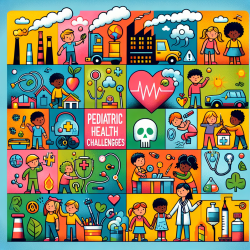The health of our children is paramount, yet environmental pollutants continue to pose significant risks. The research article "Environmental pollutants and disease in American children: estimates of morbidity, mortality, and costs for lead poisoning, asthma, cancer, and developmental disabilities" provides crucial insights into how these pollutants affect pediatric health. Understanding these impacts is essential for practitioners who aim to improve their skills and advocate for better health outcomes.
Understanding the Impact
The study highlights four major categories of illness linked to environmental toxins: lead poisoning, asthma, cancer, and neurobehavioral disorders. The research uses an environmentally attributable fraction (EAF) model to estimate the proportion of each illness attributable to environmental toxins:
- Lead Poisoning: EAF is 100%, indicating a direct link between lead exposure and poisoning.
- Asthma: EAF is 30% (range 10-35%), suggesting a significant portion of asthma cases are related to environmental factors.
- Cancer: EAF is 5% (range 2-10%), showing some cancers in children are influenced by environmental toxins.
- Neurobehavioral Disorders: EAF is 10% (range 5-20%), indicating a notable connection with environmental pollutants.
The study estimates the total annual costs of these diseases at $54.9 billion, underscoring the economic burden alongside the human cost. This figure represents 2.8% of total U.S. healthcare costs and highlights the need for increased resources for research, tracking, and prevention.
Improving Practitioner Skills
Practitioners can enhance their skills by integrating the findings of this research into their practice. Here are some actionable steps:
- Stay Informed: Regularly update your knowledge on environmental health through conferences, webinars, and publications.
- Advocate for Change: Use your position to advocate for policies that reduce children's exposure to harmful pollutants.
- Educate Families: Provide information to parents about reducing exposure risks in their homes and communities.
- Pursue Further Research: Engage in or support research that explores additional environmental factors affecting children's health.
The Path Forward
The findings from this study serve as a call to action for practitioners. By understanding the links between environmental pollutants and pediatric diseases, practitioners can play a pivotal role in advocating for healthier environments for children. This involves not only treating illnesses but also preventing them through education and policy change.
The journey towards healthier children requires a collective effort from healthcare providers, researchers, policymakers, and communities. As practitioners deepen their understanding and commitment to addressing these issues, they contribute significantly to shaping a healthier future for all children.
To read the original research paper, please follow this link: Environmental pollutants and disease in American children: estimates of morbidity, mortality, and costs for lead poisoning, asthma, cancer, and developmental disabilities.










